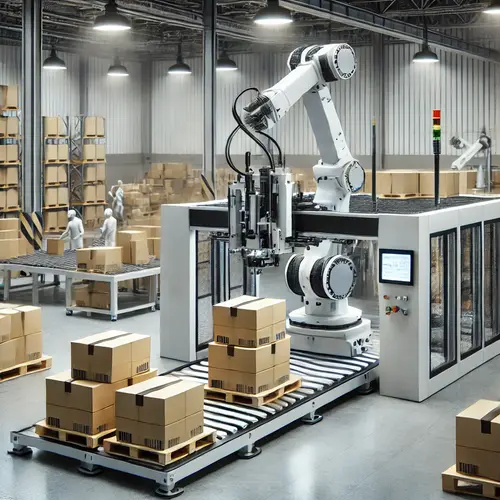Palletizer Market Soars Amid Rising Demand: A Strategic Look at Industry Growth

Strong 8k brings an ultra-HD IPTV experience to your living room and your pocket.
The Palletizer Market has experienced significant growth, driven by increased automation in industries like food & beverage, pharmaceuticals and logistics. The rising demand for efficiency in material handling, reducing manual labor and improving workplace safety has positioned palletizers as a critical component in modern production facilities.
What is a Palletizer?
A palletizer is a machine that automatically arranges products, such as boxes or cases, onto pallets for storage or transportation. These machines come in various forms, such as conventional palletizers, robotic palletizers and semi-automatic palletizers, each tailored to meet specific industry needs.
Key Drivers Behind the Market Surge
Automation in Manufacturing: With the global push toward automation, industries are looking for solutions that streamline production processes, reduce human error and maximize efficiency. Palletizers, which can operate at high speeds, have become indispensable in achieving these goals.
Rising E-Commerce: The explosion of e-commerce has also contributed to the demand for palletizers. E-commerce businesses need efficient, high-throughput systems to manage a vast inventory of goods, making palletizers essential for timely order fulfillment and shipping.
Labor Shortages: The ongoing shortage of skilled labor in many countries has pushed companies to adopt automation solutions like palletizers, helping to reduce the dependency on manual labor while maintaining high production output.
Technological Advancements: Modern palletizers incorporate advanced technologies like artificial intelligence (AI), machine learning and vision systems, enabling faster, more accurate operations. These innovations are making palletizers even more attractive to industries seeking cutting-edge solutions for material handling.
Sustainability Efforts: Many industries are striving to reduce their environmental footprint by minimizing waste and energy consumption. Palletizers aid in this by optimizing the packaging process, reducing the need for excess materials and ensuring consistent stacking to minimize transport emissions.
Market Segmentation
Type:
Conventional Palletizers: These are more mechanical and operate based on pre-set patterns.
Robotic Palletizers: Equipped with robotic arms, they offer greater flexibility in arranging products of various shapes and sizes.
Semi-automatic Palletizers: These machines require some manual intervention but are more cost-effective for smaller operations.
Industry:
Food & Beverage: One of the largest sectors, where high-speed palletizing is essential for processing packaged foods and drinks.
Pharmaceuticals: Palletizers ensure efficient handling of medical products and can be integrated into sterile environments.
Logistics & Warehousing: E-commerce and third-party logistics companies are increasingly adopting palletizers for faster throughput.
Consumer Goods: Palletizers play a crucial role in efficiently handling large volumes of packaged goods.
Region:
North America: Leading the market with a high degree of automation in industries.
Europe: A strong market for both robotic and conventional palletizers.
Asia-Pacific: Expected to witness the fastest growth, driven by the region's booming manufacturing sector and growing adoption of automation technologies.
Leading Players in the Palletizer Market
Several key companies dominate the global palletizer market, including:
ABB Ltd.
KUKA AG
FANUC Corporation
Honeywell Intelligrated
Yaskawa Electric Corporation
These companies continue to invest in innovation, integrating advanced robotics and AI to enhance their palletizer offerings. Their focus is on providing customized solutions to cater to different industries' unique material handling needs.
Challenges Facing the Market
Despite the optimistic outlook, there are a few challenges that the market faces:
High Initial Costs: The cost of installing advanced robotic palletizers can be prohibitive for small and medium-sized enterprises (SMEs), limiting market penetration in this segment.
Maintenance and Downtime: While palletizers can dramatically increase efficiency, they also require regular maintenance to prevent downtime, which can affect overall productivity.
Training Requirements: The integration of advanced technologies like AI in palletizers requires skilled personnel for operation and maintenance, further adding to the costs.
Future Outlook
Looking ahead, the palletizer market is set to continue its upward trajectory. With advancements in AI and machine learning, the next generation of palletizers is expected to be more efficient, intuitive and capable of adapting to various products and pallet configurations. This will make them more accessible and attractive to businesses of all sizes.
Moreover, as companies worldwide prioritize automation to remain competitive, demand for palletizers will only increase. The rise of Industry 4.0, which emphasizes smart factories and interconnected systems, will further boost the adoption of palletizing systems integrated with real-time monitoring and data analysis.
Conclusion
As industries look for ways to enhance productivity, reduce costs, and improve workplace safety, the palletizer market is expected to grow rapidly. Companies that invest in cutting-edge palletizing technology will find themselves well-positioned to meet the growing demands of global markets. Whether it’s high-speed food production or managing an e-commerce warehouse, palletizers are proving to be an indispensable tool in the journey toward full automation.
Note: IndiBlogHub features both user-submitted and editorial content. We do not verify third-party contributions. Read our Disclaimer and Privacy Policyfor details.






